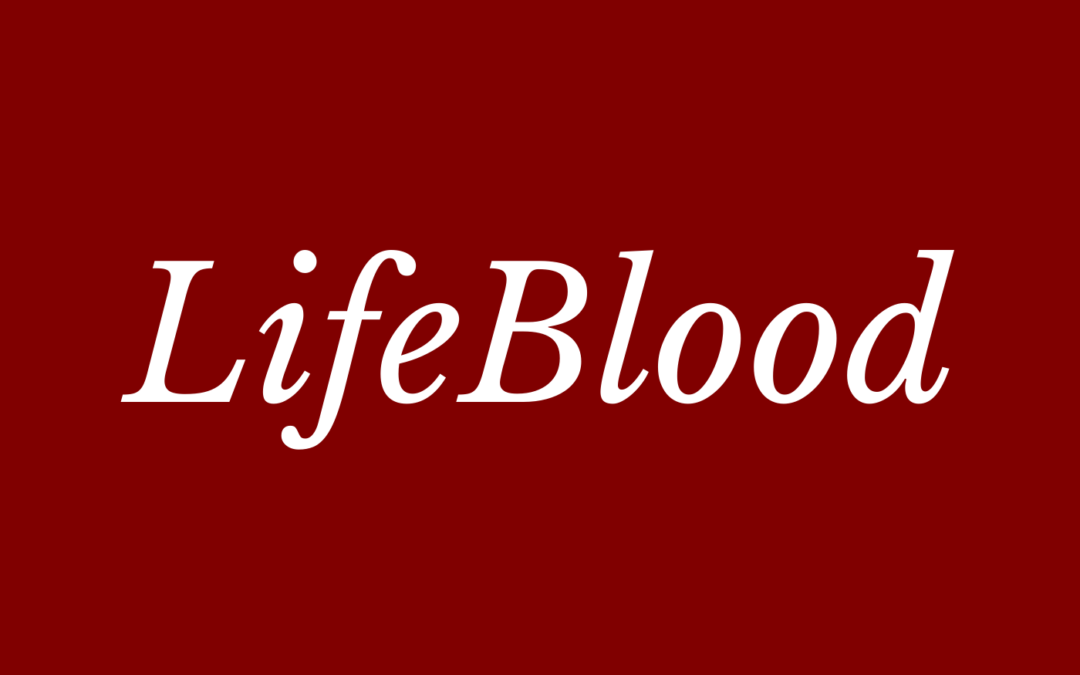Immersive VR with Marshall Mosher
How could an immersive VR experience improve your culture and team at work? Marshall Mosher talks about the potential impact and how to make it happen!
Listen to us On
About the Episode
LifeBlood: We talked about immersive VR, using this new and exciting technology at work for team and culture building, how it works for in-person and remote teams, and how to bring it to your org with Marshall Mosher, extreme sport athlete, Founder and CEO of Vestigo and podcast host.
Listen to learn why investing in your culture and team pays massive long-term dividends and how to do it in a new and exciting way!
You can learn more about Marshall at Vestigo.co, Facebook, Twitter, Instagram, Vimeo and LinkedIn.
Thanks, as always for listening! If you got some value and enjoyed the show, please leave us a review wherever you listen and subscribe as well.
You can learn more about us at LifeBlood.Live, Twitter, LinkedIn, Instagram, YouTube and Facebook or you’d like to be a guest on the show, contact us at [email protected].

George Grombacher
Lifeblood Host

Marshall Mosher
Guest
Episode Transcript
Come on one life, this is George G. And the time is right welcome. Today’s guest is strong and powerful martial, Moshe Marshall. Are you ready to do this?
Marshall Mosher 0:19
Yeah, looking forward to it. Thanks for coming on George.
george grombacher 0:21
And excited to have you on Marshall is empowering human connection and virtual reality adventure. He is a jet suit pilot. He is the founder and CEO of testigo. And a podcast host excited to have you on Marshall. Tell us a little about your personal life some more about your work and why you do what you do.
Marshall Mosher 0:40
Yeah, absolutely. Well, like you said, thanks for that awesome intro, I really love creating opportunities for people to come together around really impactful and meaningful connection experiences. My personal background is in the outdoor adventure space. When I was in college, originally, I was studying pre med and realized I didn’t want to go to med school. And throughout that whole journey of realizing I wanted to go into entrepreneurship. My campus job at the time was actually as a guide for the outdoor recreation program where I went to school at the University of Georgia. And I saw the impact that experiential learning had experiential learning being this term that we use in the outdoor industry of using a environment that gets people outside of your comfort zone that challenges our perceived limits, to allow the individuals that are going through that challenge to bond on a deeper level than we could in just a typical, you know, kind of comfortable or familiar environment, whether it’s, you know, an office or conference room. And I wanted to find a way to bring that type of experience, that really powerful adventure experience that I saw, through my time as a guide there, into the workforce in an accessible way to allow companies to train their team with themes and leadership development, and relationship building through these really powerful experiences that allow people to build much stronger connections. But the challenge was that as impactful as these adventure experiences are, they’re also sometimes a little bit inaccessible. It depends on you know, levels of physical fitness, training, physical location. So I knew there was another way and my, one of my other passions, in addition to adventure sports is also technologies, I really love the intersection of adventure and technology. And at the time, we were first getting started virtual reality was kind of having its moment in the sun finally taking off in a big way, about you know, six years ago, of course, has come a long way since then. But I love the impact that virtual reality had in making these impactful experiences, all the sudden, extremely accessible. So I’ll tell you more about that in a little bit. But for me, personally, I do what I do, because I love creating these opportunities for people to have really powerful connections, and empowering people to get outside of their comfort zone through adventure experiences. And in my personal life, I of course, love adventure. of all different types of sports personally, as well actually work remotely from a camper van, which is what I’m in right now, where I travel around to some of my favorite adventure spots, whether it’s paragliding, skiing, snowboarding, mountain biking, kiteboarding, and can lead virtual reality experiences from remote setting while being able to actually go out and do those things in real life that I love as well and kind of balance that passion for in person adventure and pushing my own boundaries and limits in the real world. And helping people to do that in virtual reality as well.
george grombacher 3:39
Amazing, super cool. And I believe that you’re the first person to, to to be a guest on the show from a camper van or from a remote location. So I think that was well so sweet. Alright, so, so much cool stuff to dig into with you. And I mean, all those things you just described, we could probably talk about for hours for you, and the way that you view things you get in a jet suit. That would be terrifying for the majority of people, myself included, and so would starting a business instead of going to medical school. So would get in a camper van just going around the world. Do you not experience anxiety, fear? How do you think about that? Or if you do at all?
Marshall Mosher 4:27
Yeah, that’s that’s a really great question and something that I’ve heard quite often. So if we if we take a second to scroll through YouTube or Instagram or Tiktok in the adventure section and search the hashtag adventure, you’ll see all kinds of crazy clips of these Red Bull athletes doing you know, bail rolls at a speed weighing paraglider jumping off cliffs, all these ridiculous things and we think to ourselves, these people must be completely fearless. They clearly have something wrong in their head that makes them different from others. But what’s actually going on is they’ve spent years and years practicing not only the technical skills of that sport, but the mental ability to push through the fear that we all have, that we all innately are born with, and gets the other side. And not just an increased level of skill in that sport, but increased mental ability to push through the challenges that we we all navigate in life, whether it’s jumping off a cliff in a wingsuit, or taking on a new role in the office, the fear of failure, the fear of the unknown, biologically is actually the same. So our ability to get outside of our comfort zone, in environments that are just pure raw terror, that the Outdoor Adventure World can so effectively create in, you know, in a very safe and accessible way in some sports can translate directly into our ability to push through fear in other environments. So I, while I love doing all this stuff, like for instance, one of the reasons why I’m here in Telluride, besides skiing and snowboarding is because I love paragliding that’s been the sport that I’ve been really obsessed with over the past few years since I’ve got started. Telluride is one of the handful places in the country that actually allows paragliding from the slopes in the US most ski resorts do not because of insurance and liability, but but this spot does. And every time that I go up to launch, especially in a very Alpine place like Telluride, I feel those same feelings of fear and doubt and uncertainty. And especially when it’s a snowy launch, and I’m on skis. And I look down on the launch, I’m like, Man, if I, if I mess up, this launch, goes off a cliff, there’s no room for error, I feel those same things. Definitely feel the fear of failure and the consequence of that, but it’s not the presence of fear, or the absence of fear, it’s our ability to push through it that really matters. And that’s one thing that I love, both in the work capacity of what I do with fast ego and in my personal life.
george grombacher 7:01
I love it. It’s not the presence or the absence of fear, it’s your ability to, to press through it. So how does that does that sounds like it probably translates directly to how you’re helping organizations and the employee or the actual people themselves have that experience without the possibility of death?
Marshall Mosher 7:22
Right, exactly. Yeah, the really awesome thing with virtual reality, and with some real life adventure sports is that we can simulate an environment that makes your amygdala the part of your brain responsible for fear go absolutely crazy. Without the actual presence of any risk. A fear of heights is a really good way to do this. It’s extremely strong, instinctual fear that we’re all born with. When we get up to the edge of a cliff, we look down and our brain says, if you take one more step, it’s gonna be a bad day, don’t do that we have this extremely strong spirits bonds. But if we create an environment, even in the real life world that makes you extremely safe, like let’s say you’re standing on the edge of, you know, a balcony and you have a railing, there’s no way you could fall over this railing. But when you walk up to the railing, let’s say the top of the Empire State Building, you still get those same fears, those same emotions, even though the you know, logical part of your brain says you’re safe, this building isn’t going where anywhere you have a railing, we can do the exact same thing with rappelling. So it’s a kind of a subset of climbing where you start at the top of a cliff, you hooked into a harness and a rope, and you’re just walking down the cliff and going with gravity. And the same thing happens, but in a stronger way, where your brain says you’re on the edge of a cliff, you’re gonna fall. But the kind of base level of your brain the amygdala part doesn’t really understand the logical part that you’re hooked into a rope system that makes you completely safe. There’s no really physical fitness constraints, you’re just going down with gravity, it’s like riding an elevator down. But you still have that same fear response. Interestingly enough, we can actually replicate that in a virtual environment with virtual reality when there is literally no presence of any actual real danger. Of course, when you rappelling, you still think, Oh, well, what if the anchor system breaks? What if the ropes break? They don’t they could hold a semi truck off that cliff. And we still think that in virtual reality, we feel the same emotions when let’s say we’re on a virtual ladder crossing a virtual crevasse at the base of Mount Everest, and below us is a 200 foot, you know, icy pit of death that we might fall into if we fall to one side or the other of the ladder. And our brain tells us we should be scared, same fear response happens. But then we start thinking to ourselves logically, well, we’re on our living room for we’re in our office, there’s literally nothing that could hurt us. Maybe we could, you know, Chip and fall to the ground, but we’re completely fine. But regardless of that fact, the fear response or brain still creates the same response, same emotions, which is really changing, Pina that virtual reality presents because it allows weights in a way that’s for one extremely accessible to put on a headset, but also you very effective and meaningful.
george grombacher 10:02
Yeah. Amazing. So, when when, why why do organizations reach out to you? Or what’s what’s what’s, what’s the motivation?
Marshall Mosher 10:15
Yeah, so one of what there’s kind of two, two main reasons. One, is what we’ve always sort of had as our main focus and other is more recent, the main theme is that a lot of companies are really struggling to create an innovative work culture. And in this day and age where everything changes so fast, the only certainties a lot of uncertainty, companies have to have a team that more than anything else is a rockstar in their ability to navigate, change and push through the unknown. And that ability really goes back to our psychological ability of being willing to get outside of our comfort zone, and push through the fear of not knowing what’s on the other side. And that’s a big part of the innovation process, in order to take a big risk and navigate a path that no one has taken before. The same fear responses come up as if we’re walking cross that virtual crevasse at the base of Mount Everest, it, it allows us to have an opportunity where we can decide do we take a step forward and navigate the road that hasn’t been traveled, even though our brain and our fear response is telling us no, but the right answer is yes. So training, that just basic psychological factor actually makes a huge impact on our willingness to get outside of our comfort zone in the innovation process. And there’s a lot of psychology research that goes into why that is. But it’s a pretty, pretty meaningful and effective way to do it. The other factor is that when you’re going through these experiences, you not only have an opportunity to push through your own fear, but the opportunity to be the support and the encouragement of the team that’s going through that experience with you. So you also form really strong and, you know, meaningful and durable relationships with the people that you go through those experiences with. It’s a really interesting work that’s gotten really popular, from Brene Brown on the power of vulnerability. And when we go through an experience that is challenging and scary. And we’re willing to be vulnerable about the fact that we’re terrified to go through this experience. And even though we’re terrified, we’re going to rely on the support of our team to be able to push through, that creates a really powerful opportunity for personal connection, bonding with the others who are going through that with you. So a lot of teams these days are going completely remote because of COVID, or at the very least, a hybrid remote kind of work structure. And in that environment, it’s very difficult to build meaningful relationships with people that you never see or rarely see, in a in person context, of course, you can interact with someone on Zoom. But at the end of the day, it’s still a picture on the screen, having that personal connection is the first piece but then also having the opportunity to go through a powerful experience, physically with someone is the best thing that you can do. And in virtual reality, we can actually have the entire team there in VR as virtual avatars. And when you’re going through this experience, it’s not just a video you’re watching, you’re actually in this experience with the virtual avatar versions of your coworkers that are going through that experience with you. That with a person that might be hundreds or 1000s of miles away, and you can have that relationship and have that interaction completely virtually, in VR. So it’s really powerful from a relationship building standpoint for remote teams, and from an innovation training standpoint, to build that mindset of courage and navigating the unknown.
george grombacher 13:47
Yeah, super cool. So you’ve obviously figured out how to get is it headsets his glasses? What What, what, what is it these days?
Marshall Mosher 13:59
Yeah, so there’s a bunch of different virtual reality headsets out there. Maybe one day, they’ll be glasses, I think it’s going in that direction. But right now we use the Oculus quest, VR headset, it’s the easiest to use, and the most accessible, cheapest one out there. It’s what a lot of companies are starting to buy for their employees. So we do have a big inventory of headsets that we can send out for companies that want to explore what virtual reality is, like, let’s say company wants to do a team got together in VR, but no one has the hardware. We can come in, send a headset, ship each headset individually to each individual employee. And then everyone comes together in virtual reality. And we coach the individual people on how to use that headsets. It’s usually each person’s first time. That’s usually how companies get started in VR. But what we’re mostly focused on is actually working with companies who’ve already understood the impact that virtual reality can have as a tool and bought the hardware for their team. So companies like Accenture, by the way, that’s one of our clients, they bought 70,000 VR headsets Wow are a massive part of their team with plans to expand to most of the team, eventually. And they’re using those headsets for all kinds of things from remote office space to virtual team engagement and leadership development opportunities. So companies that have bought the hardware, we’re really hoping to come in and help them on the software side of what we can do, once you have that hardware, in terms of engaging and building your team, from a software standpoint, and that’s our main focus. Now, of course, there’s not a lot of companies that are out there that are like that. But it’s kind of like when the computer and the personal computer first came out. Most companies have the computer in the office, it was rare to have someone have their own computer. But then eventually, companies started realizing the power that that person could could bring to the team if they actually were able to have access to the computer 24/7 at their house and laptops. So we’re right on the edge of that happening with virtual reality. And 2022 is going to be a big year for that.
george grombacher 15:59
Yeah, fascinating. So much stuff to think about that you’ve never thought about until you start thinking about it martial. And exactly, you recognize and realize that anything is literally going to be possible and super cool. So how many different programs do you have? I don’t know if that’s the right way, or how many different experiences do you take companies through?
Marshall Mosher 16:24
Yeah, so we have, we have three different ones that we mainly lead right now and we’re constantly building out more. Our our main one is that Evers cross crossing experience that I talked about, so it’s mainly focused on helping teams get through that mindset of fear, navigating the unknown, really focus on the innovation component, but also really great opportunity to bring teams together and build those, you know, in person connections, even though we’re not in person. So we recreated a version of Everest base camp with a big projector so everyone initially ends up you’re streaming into base camp teleporting there. You can walk around, explore it. And then there’s this big screen where we have a real life Everest mountaineer as someone who has climbed Everest and uses those experiences for executive coaching and leadership development, actually give a keynote speech presenting on the screen right there, the base of Mount Everest talking through the correlation between that person’s journey at Everest and the themes we’re going to talk about from a leadership development standpoint, and that at the end of that, like 30 minute keynote, everyone then teleports into the first step in climbing Everest, which is crossing a big glacier called the Khumbu Icefall, which is in this constantly moving frozen, you know, river of ice with these big cracks in the ice, and you have to cross those cracks by walking cross these ladders they put across, and that’s the, the fear inducing challenge of the experience. And then we, you know, tie a lot of the experiential themes together with the debrief, going back to Everest base camp, everyone can hang out, kind of have a virtual Happy Hour kind of thing. And then, and then, you know, sometimes people will get to follow that up with us in person experiences, but that’s generally the main one from a virtual reality standpoint. But then we also have an experience that’s focused specifically on communication under pressure. So how teams actually work together to solve a problem, when it’s a confusing and stressful challenge in front of you. So we have this virtual time bomb with a bunch of buttons and wires, and absolutely no idea how to defuse it. And the person that is in front of this virtual time bomb feels like if they don’t defuse it, at the end of this five minute countdown timer, it’s going to explode. The rest of their team has the instruction manual on how to defuse that the people with instruction manual, do not have the visual sight of what is actually in front of the person defusing the bomb, and the person defusing the bomb doesn’t have instruction manual. So they have to communicate what they see and do that effectively in a time sensitive manner, solving tasks they’ve hopefully never attempted before. So that really is created a teaching communication specifically. So all kinds of things that focus on different types of themes and leadership development. But ultimately, at the end of the day, empower us to get outside of our comfort zone, and build strong relationships with the people that go through those experiences with us.
george grombacher 19:21
Oh, cool. Very cool. Very cool. Yeah. Well, Marshall, the people are ready for your difference making tip. What do you have for them?
Marshall Mosher 19:29
Yeah. So for companies that are trying to navigate this world of remote work, I think the most important thing that we’ve seen in terms of the teams that we’ve worked with, especially the ones that have been able to not just retain their best talent, but recruit really amazing talent is to not be resistant of new trends like you know, going fully remote or things like that. But to accept change and also to really invest in the team that’s going through that chain should really, let’s say, you know, take budget from reducing the size of the office and not just save that on the books, but put that directly into investing in the people that now no longer have as much of an opportunity to connect in person, whether that’s through experiences, like what we do, or anything else, not forgetting that the team and the people that make up the team is the single most important factor of a company’s success or failure, and putting a lot more effort into investing in engaging that team, building the team and growing the team is what we have seen as the kind of the secret sauce, the game changer for companies that tend to be really effective in what they do.
george grombacher 20:49
Well, I think that that is great stuff that definitely gets a come up. Arsal Definitely. Thank you so much for coming on. Where can people learn more about you and how can they engage?
Marshall Mosher 20:58
For sure they can go to our website, invest diigo.co. And if anyone wants to reach out to me personally, they can always follow me and message me on Instagram at Marshall Mosher or shoot me an email Marshall at best ego.com Perfect. Well, if
george grombacher 21:14
you enjoyed this much as I did show Marshal your appreciation and share today show the friend who also appreciates good ideas go to wwsd ego.co. It’s VST Igo that co founder Marshall on Instagram, and I’ll list everything in the notes of the show. Thanks again, Marshall. Thanks, George. And until next time, keep fighting the good fight as we’re all in this together.
Transcribed by https://otter.ai
More Episodes
Personal Responsibility: How To Get More In Your Life
I recently had the pleasure of having Jamie Lerner on the LifeBlood podcast to talk about personal responsibility and how we can get more of it in our lives. You can find her episode here. Jamie shared some of the wisdom she’s learned over her career as a...
Our Favorite Quotes About Dignity and How You Can Apply Them in Your Life
Dignity is “The quality or state of being worthy, honored, or esteemed.” Wikipedia defines it as “is the right of a person to be valued and respected for their own sake, and to be treated ethically. It is of significance in morality, ethics, law and politics as...
How to Have a Greater Sense of Personal Responsibility by Taking Personal Initiative
How often do you see something and think “how is that happening?” or “why is that the way it is?” When you look at your community, is there anything you’d change? Here’s the thing; you’re the right person to make those changes. You’re the right person to...
A Family Trust: How to Get Your Estate Plan Done without Breaking the Bank
The family trust has been a powerful estate planning tool for a long time. The need for what trusts do came about in the 12th century, and family trusts have been used for a long time as well. Over a century ago, Frank Mars (candy bars) created a trust which had the...
Get Good with Money: Five Things you Can Start Doing Right Now While Still Enjoying Coffee
I love getting coffee. I mean, I really love it. Sure I love coffee itself, but there’s something about the action of going into the coffee shop, the whole experience of it I’m super into. I haven’t dug into why I like it so much, I just know that I...
Get Out of Debt by Avoiding Comparison
Teddy Roosevelt famously said, “Comparison is the thief of joy.” Another related well-known quote is, “Too many people spend money they haven't earned, to buy things they don't want, to impress people that they don't like.” It’s a very human thing to...
How to Get Financial Peace of Mind
Merriam-Webster defines peace of mind as a feeling of being safe or protected. What does having peace of mind mean to you? When I start feeling overwhelmed, stressed out, anxious, or a combination of all of them, I think about the Serenity Prayer: God, grant me the...
How to Find Your Old 401k and Roll it Over without Paying Taxes or Penalties
Old 401(k)s. Odds are, you probably have one. Maybe it’s an account at a job you had for six months and there’s $1,000 in it. Or maybe it’s from a previous career where you were at the company for 10 years and there’s a $100,000 balance. Either way,...
How to Catch Up if You Don’t Have Enough Saved for Retirement so You Don’t Have to Move in with Your Kids
All kidding aside, you moving in with your kids isn’t an attractive scenario for you, or them. A top concern for many Americans is not having enough money saved for retirement. If that’s true for you, I’m going to get you moving in the right direction so...
Join the show.
Interested in being on the show? Tell me a little bit more about you and what you’d like to talk about!














